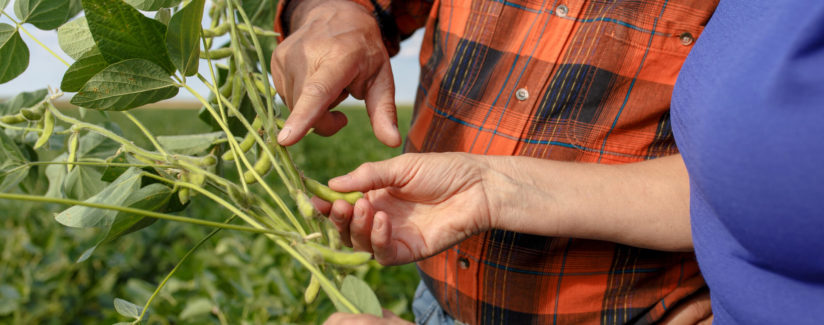
Five Things You Might Not Know about Soybeans
03/29/2019
Soy is a common source of protein and appears in tofu, as well as an ingredient in many different types of food, such as salad dressing, chocolate and baked goods.
Soy comes from soybeans – a crop grown by farmers throughout the United States – in states such as Ohio, Illinois and Minnesota as well as Canada. We like to dig into the information behind how our food is grown and many of us want to know if our food is sustainably grown, so we found these interesting facts about soy and soybeans.
1. Soybeans create some of their own fertilizer.
Soybeans are in a class of plants called legumes which have the unique ability to use nitrogen that is in the air. Microorganisms that live on the soybean roots convert atmospheric nitrogen into a form that the plant can use. In turn, the plant feeds the microorganism. When the plant decays, the nitrogen that has been pulled from the air is released into the soil. Growing soybeans in a field can add 30 to 50 pounds of nitrogen per acre into the soil.
2. Every part of the soybean is used in some way.
After farmers harvest the beans from the field, they are processed, where the bean is separated into two parts. Most of the bean is meal, which contains protein, and is used in food products or feed for animals, such as chickens, pigs and cows.
The other portion of the bean is oil, some of which is used as cooking oil, which is commonly labeled vegetable oil. It is also used in many different products –machine oil, paint, candles, beauty supplies and even crayons.
3. Soybeans are renewable fuel.
Soybeans are used to make a renewable fuel known as biodiesel. Compared to petroleum-based diesel, biodiesel produces fewer air pollutants, such as carbon monoxide, sulfur dioxide and hydrocarbons.
Biodiesel is considered to be carbon-neutral because soybean plants absorb carbon dioxide as they grow, which offsets the carbon that forms while making and burning biodiesel.
Any diesel vehicle can use biodiesel, or a blend of biodiesel and petroleum diesel. More than 9 billion gallons of biodiesel are used worldwide each year.
4. Soybeans can replace petroleum in common products.
The oil from soybeans is chemically similar to petroleum and many manufacturers are using soy oil in their products because it is a more sustainable option. Soybean oil is used in tires, creating a tire that is more flexible in cold weather. Soybeans are used in flooring products to create Leadership in Energy and Environmental Design (LEED) certified buildings that meet environmental targets. It’s also used to make environmentally safe cleaning products.
5. Soybean farmers are growing more using less natural resources.
Scientists and farmers have worked together to make raising soybeans sustainable for the environment. They have adopted practices to be more efficient, so food can be grown using less land, energy and water. From 1980 to 2015, farmers cut their energy use by 35 percent and invested in soil conservation to preserve land. By using technology, such as GPS and seeds that require less pesticides, farmers reduced greenhouse gas emissions by 45 percent during that same period.
Soybeans are a versatile crop that helps create environmentally friendly products. Growers continue to look for ways to make the crop even more sustainable.
Sources:

























